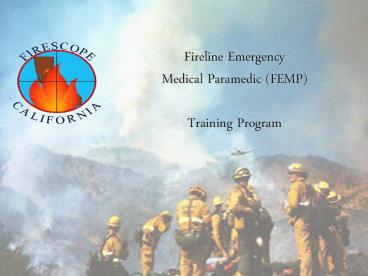Fireline Emergency Medical Paramedic (FEMP) Training Program - PowerPoint PPT Presentation
1 / 20
Title:
Fireline Emergency Medical Paramedic (FEMP) Training Program
Description:
Fireline Emergency Medical Paramedic (FEMP) Training Program Objectives Outline the role and responsibilities of the FEMP Describe the training and education that is ... – PowerPoint PPT presentation
Number of Views:278
Avg rating:3.0/5.0
Title: Fireline Emergency Medical Paramedic (FEMP) Training Program
1
Fireline Emergency Medical Paramedic
(FEMP)Training Program
2
Objectives
- Outline the role and responsibilities of the FEMP
- Describe the training and education that is
required to become a FEMP - Describe what equipment and supplies are utilized
by the FEMP - Discuss scope of practice, documentation
requirements and the disposition of patients - Review the principles in dealing with inmate fire
crews
3
Prerequisites for FEMP
- Complete the basic requirements for FEMP position
- Complete this self paced educational module
- Approval and verification by the employing agency
fire chief to be able to deliver quality advanced
life support (ALS) care in an arduous and austere
environment. - Home agency will supply required EMS equipment
and medication for the FEMP as described in the
position description.
4
Role of the FEMP
- Fireline (may be vehicle based)
- Base Camp
- Spike Camp
- Helispot
5
Arrive at the Incident
- Check-In
- Radio (clone or obtain)
- Obtain assignment (you should be paired)
- Obtain fireline supplies as necessary
- Contact time unit when possible
6
Equipment and Supplies
- Bring what you need (surplus in vehicle)
- Replace through MEDL (except meds)
- Reimbursement process
- Narcotics
- Resupply
- Storage
- Waste procedure
7
FEMP Scope of Practice
- Only permitted to practice as if in your home
unit - Consider on-line medical control when necessary
- Equipment list includes use of Metered Dose
Inhaler (MDI) - MEDL to notify host LEMSA
8
Fireline Considerations
- Care may be temporizing
- Provide ALS care in an austere environment
- Altitude sickness
- Burns
- Snake bites
- Lots of minor first aid
9
Disposition of Patients
- Air transport
- Ground transport
- Transport can be to either acute care facility or
to the MEDL - Return to fireline
10
Helicopter Considerations
- Risk vs gain
- Safety practices
- Communications
- Aircraft capabilities
- Supply delivery
11
Documentation and CQI
- Copy of PCR
- to home agency for disposition per home policy
- to MEDL
- to follow patient
- Primary CQI responsibility of home agency
12
Required Training
- California EMT-P License and local EMS Agency
accreditation - Firefighter Training (S-130)
- Look Up, Look Down, Look Around (S-133)
- Introduction to Wildland Fire Behavior (S-190)
- Incident Command System ICS 100 and ICS 200
- Basic air operations course content
13
Additional Training
Which Supports Development of Knowledge and
Skills
- Wilderness Emergency Medical Technician
- Introduction to Air Operations (ICS S-270) or
equivalent
14
Physical Requirements
- The work involved in this position is ARDUOUS
Arduous involves field work calling for
above-average endurance and superior
conditioning. For example, the USFS arduous pack
test requires carrying a 45 pound pack for 3
miles within 45 minutes without running.
15
Personal Equipment
- Review Appendix C of the position description
- Varies by assignment
- Limit pack weight
16
Communications
- Check in with your line supervisor
- Review the communications plan
- Confirm operational status of your radio
17
Mapping
- Obtain incident map
- Identify Divisions and Branches
- GPS operation
- Map reading skills
18
Working with Inmates
- All crew members have the right to be treated
with fairness, maturity, impartiality and respect - Obtain custodial permission to treat from crew
supervisor - If the inmate crew member needs to be
transported, arrangements must be made for
custodial staff to follow.
19
Working with Inmates
- Medical Emergency Response Team (MERT) and/ or
DMAT may be established at the incident base - Refrain from casual conversation with inmate crew
members - Do not give to or take ANYTHING from inmate crew
members without approval from the crew supervisor
20
If you have further questions about this
position, please contact your training officer
and the FIRESCOPE website.































